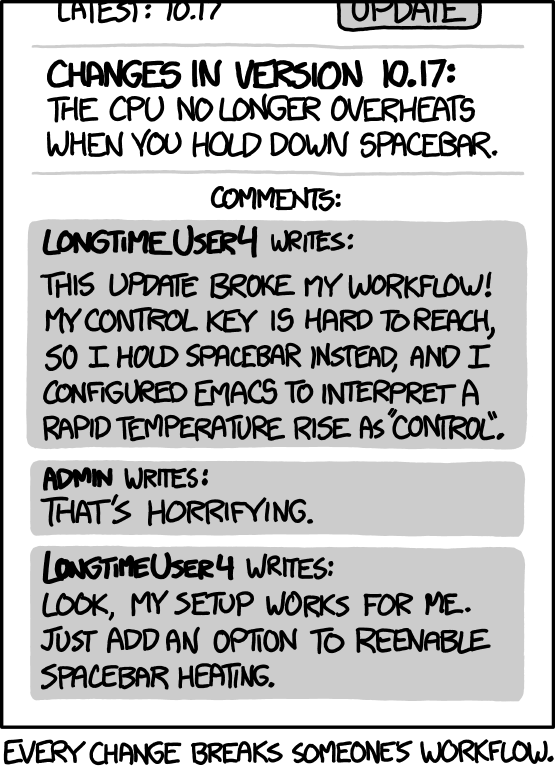- cross-posted to:
- creative@beehaw.org
- cross-posted to:
- creative@beehaw.org
Courtesy to Twitter user XdanielArt (date of publication: 8 June 2024)
Honestly, GIMP is not a good alternative to Photoshop. I know, “it’s free” is enough for many people, but it … just isn’t.
With GIMP 3.0 it’s a bit better at least, they’ve finally added non-destructive editing:
https://www.youtube.com/watch?v=qfaq-Cm1ZkAFull changelog here:
https://www.gimp.org/release-notes/gimp-3.0.htmlI’d dare say that unless you’ve already learnt Photoshop (and have to unlearn it) then Darktable+GIMP works fine for home photo editing.
If you’re used to Photoshop and your skills with it is what puts bread on the table… then I completely understand not switching tools.As somebody who has been trying to decided which of the RAW photo editors to use, I can tell you that Darktable has a steep learning curve over Lightroom. The UI is incredibly dense and the names of sliders don’t make sense unless you’re an image science expert.
I’ll take your word for it, I’ve never used Lightroom.
Whenever I played around with Darktable it seems finding a tutorial to get the effect I wanted was just a minute of searching away, and there’s a ton of beginner tutorials available too.
https://www.darktable.org/2024/12/howto-in-5.0/But then I was the kid that rtfm the game manual on my way home from the store and love dense UIs as an adult. :)
Been usin DT for close to a year now. I agree the learning curve is a little steeper than light room but once you get it, everything clicks into place. I can’t believe how powerful this program is and it’s free. It’s unbelievable
Darktable is a godsend to me for converting film negatives.But I pretty much only use image conversion, RGB curve, then fidget with the exposure and RGB sliders in negadoctor a little more then I’m done. No idea how to do anything else.
Yeah but it should tell you something that they just figured out non-destructive editing by 2025. Love the team, want to see it succeed, but it’s not PS at all.
My understanding is that a lot of tech debt has been removed with the release of 3.0 and I’m hopeful it will make future updates simpler and faster. :)
I want to make GIMP work for me but it’s the small things like trying to select a layer and move it with the arrow keys but the arrow keys instead are incessantly switching between layers for some reason? I find the fussiness of layer selection among other stacked layers in your canvas frustrating also.
I wish there was a plugin that made everything work exactly like Photoshop, made all keyboard shortcuts Photoshop user friendly, added content aware fill, etc…if these issues would be fixed then I’d use it more often. (I found and tried to install PhotoGimp for my Gimp install on my Mac but alas it didn’t work…recommendations?)
“It didn’t work” gives very little to work with, all I can recommend is to follow the instructions:
https://github.com/Diolinux/PhotoGIMP?tab=readme-ov-file#macosNot a mac user myself.
Rooting for them! I have had it installed for like 15 years lol
I have had it installed for like 15 years lol
Does never removing it count?
GIMP didn’t “just figure out non-destructive editing by 2025”. You’re talking as if it was something that the GIMP development team just decided to randomly add recently, after previously ignoring user demands.
The foundation for that functionality (GEGL) has been in development for ages and was also used for some functionality in 2.6 for a long time. The reason why it took this long is that it’s a pretty fundamental change to how the app works. Also, that meshed with other upcoming changes at the time. Also, small development team.
I have said several times I have gimp and support them. I didn’t think they just discovered it - I’m saying the fact that in 2025 they just implemented it is indicative of why I say they’re behind.
They do good work. Yes they’re a small team. It doesn’t change the fact that the software has limitations.
The question isn’t “are they working hard?” or “are they doing a lot for what they are/their size?” It’s “how does it stack against PS?” And of course they can’t hang with the billion dollar international company with an army of programmers.
Always with the GIMP hate. You make a better free alternative then.
If all you care about is the price its great but the UI is trash.
It’s not on the end user to make a UI that isn’t total ass.
The same with Lightroom sadly. The open source alternatives are either too buggy or have UX designed by very “opinionated” people, making them painful and frustrating to use. I currently want to get rid of Lightroom but can’t.
Give Darktable a go. I switched from LR to DT a year ago and im never going back.
I use krita way more than gimp
Krita is also more of a Paint.NET than a Photoshop replacement.
Yeah I really like what they’re doing and I applaud their efforts, but they are a solid decade behind PS when it comes to feature parity.
I assume you are right. So then I ask myself, for my own occasional use, would a standalone version of Photoshop from 2015 cover my needs?
Yeah, I think it would!
I was always a much heavier user of Lightroom than Photoshop anyway. I still need to choose between the FOSS options there.
And UI usability.
More than a decade on that. I would say the usability is so bad that they are not on track to catch up ever unless something changes. Every year or so I download GIMP and try to use it for something basic, and I always fail and give up.
It’s in the roadmap. :)
https://developer.gimp.org/core/roadmap/#guiI imagine Gimp users revolting if it ever improves a lot.
Have users ever not revolted against change? :P
I wonder if it would be feasible to create a different UI on top of the existing GIMP backend.
Look into PhotoGIMP, afaik it precisely delivers Photoshop-like symbols, maybe even layout, and shortcuts
I thought they had stopped development? Have t checked them in a decade.
Last release was in mars to make it work with GIMP 3.0
https://github.com/Diolinux/PhotoGIMP/releasesLast release was in mars
Which tech billionaire flew the dev team into space for this? /j
My go-to PS app:
All online, same controls, hell, same icons. I’m a little stunned that Adobe hasn’t sued them into oblivion.
You can pay to drop the ads, but I’m not really seeing much end user benefit otherwise. Not seeing ads ATM, maybe I blocked 'em.
It is an alternative if you are a casual user.
No
You could give Photopea a try, if you’re looking for a free (as supported) alternatives, it has all core functions and a interface that looks very familiar. No installation required so you can easily test it, and use it in any browser (not sure how well it works without mouse and keyboard or low end devices though).
If you want more than core functionality I don’t think there is a (legally) free option out there.
I love love love GIMP!!!
But yeah it’s not a PS alternative, and tbh that’s not really what it’s supposed to be or what its developers want out of it. it’s different
This meme from the late 90s is still going? It’s honestly an impressive record.
The meme that GIMP is in any way comparable to PS? Yeah, I agree.
I mean, “compares as bad” is comparable, right? :p
What the actual fuck is adobe acrobat? A pdf editor with subscription model payment? Firefox, the browser, can edit pdf files. It’s 2025.
Firefox can do basic annotating, adding text and adding pictures but it can’t make a new PDF from scratch.
You may be confusing Adobe Acrobat Reader with Adobe Acrobat? Full Acrobat is the proprietary tool to make a PDF file from scratch including some of the more complex functions.
PDF is an open standard and has been for a while, so there are now plenty of alternatives for most of the functions. LibreOffice Draw and Inkscape can do a lot of PDF creation functions but not all. There are also “print to PDF” options to create basic PDF documents too.
However some of the more niche functions are not widely supported or well supported; and there isn’t really any opensource dedicated PDF maker that I’m aware of. Layout tools are abundant but I think it’s things like building forms and document signing that is less easily replicated. There is Master PDF - a fully functional PDF maker which is proprietary and available for Linux; it $80 for a perpetual license. I’m not aware of any other alternatives myself.
In AEC work we’ve moved almost exclusively to a competing PDF tool called Blubeam, which is proprietary but very worth the price, with tools for scaling, dimensioning, and producing material takeoffs from PDF drawings. Much of what you’d use Acrobat for in a more typical office environment are absent or limited, though.
In Acrobat I can go into print preview and see what my file will print like using only black and a spot color ink, I can auto-convert RGB images to CMYK, and it has a pretty robust set of accessibility features so the visually impaired can read it.
It’s for professionals.
Adobe acrobat is THE PDF editor. PDF is a proprietary format created and developed by Adobe. Any software that can edit PDFs is doing so in a format they do not have any control over. And there just aren’t any proper PDF editors that are feature complete. now if you’re an individual who needs to make a PDF in the privacy of your own home, by all means, use a cheap or free or FOSS application to do so. But if you need that PDF to be readable and useable and seamlessly compatible on other computers for other users for ever? Better pay the Adobe tax because there is a good chance, it won’t look the way you expect it to when someone opens it up in Adobe which their company definitely has.
I’m not sure this true - PDF is an open standard. The issue isn’t generally with layout and reproducibility - a good PDF maker and a good reader will give you an accurate representation of how it looks on all devices once the PDF is created.
Certainly there isn’t a dedicated FOSS tool for make PDFs; Libre Office and Inkscape do a decent job but not perfect which may be what you’re referring to. And they’re not dedicated PDF makers plus the real problem is building fillable forms and signature tools.
But there is a proprietary alternative called Master PDF that is a dedicated and supports all the PDF standard features I believe; one perpetual license is $80 compared to Adobe subscription based charging. I’m not aware of other options myself but they may exist. But it’s a viable alternative to the “adobe tax”.
Also of course if you have Office 365 from Microsoft, you can use Word to export docs to PDF reliably (in my experience). Obviously as far as you can get from FOSS, but it is an option on Linux via web browser if you have it from work for example; at least you don’t have to pay Adobe but it’s scraping the bottom of the barrel for this threat I know!
There are a few other PDF editors that are cheaper, but they don’t have the same features. PDF seems like something that has outlived its purpose. There has to be other document formats that provide a similar or better experience and prevents alteration.
PowerPDF or Kofax or whatever it’s called now was very close to parity if not exceed functionality for most office jobs.
I don’t know how it stacks up price-wise, but I’d argue Bluebeam is a far superior PDF editing program. It even covers some word processing, Illustrator, and some PowerPoint adjacent things.
That being said, I can’t see it as practical for the average consumer.
Building off of this, the PDF standard supports all sorts of craziness. It can have embedded math and logic similar to excel files, to the point there’s templates available for banks which will automatically calculate entire loans (including weird ones like balloon mortgages and variable interest rate stuff) without leaving Adobe Reader, and the recent Doom PDF and Linux PDF projects exploit the fact that pdfs support embedded javascript.
There’s also an actual market for enterprise PDF templates like the banking ones I described with automatic calculations and whatnot. So some people literally make their living selling PDFs to businesses that businesses actually use
it won’t look the way you expect it to when someone opens it up in Adobe which their company definitely has.
That sounds like a problem between them and Adobe tbh
not true. dont oay adobe so more pdfs will look like the user intended. dont fall adobe scams like weird functions that should be in a pdf anyways. pdfs created with masterpdfeditor look exactly as intended. so, again: no, adobe is a scam. always has been.
Funny, it’s been less than 24hrs and I got a ticket in complaining about why PDFs look one way in Ease US PDF editor and totally different in Adobe Reader. You’re just wrong. I didn’t say it was worth the money to pay for Adobe, and I didn’t say it wasn’t a scam. But I do tell the truth when it comes to true parity, there are competitors to PDF editing but there is no free PDF editors that properly do the job 100% of the time.
i do not know what “ease US PDF editor” is and dont care. there are plenty of broken editors. i am saying you are wrong to think only adobe scamware can create pdfs that look as intended in the reader.
Davinci Resolve has to be one of the most jam packed free software packages available… seriously, it absolutely trounces Premiere at evvvverything
the model of free for everything except if features you’d want for producing a professional movie, and financed by hardware sales - that you don’t need unless you’re a professional - is absolutely incredible for home users
It doesn’t trounce PPro, they’re about equal IME. I’ve used both and it’s the price that makes it beat PPro. And you get the full version for free when you buy a Blackmagic camera.
personally, my reasoning for saying it trounces it is the integration of all the tools: no switching to after effects etc
but beyond that, ppro colour correction is just soooooo far behind
granted i haven’t really used it much, so i might not have “got” its workflow - it took a while for resolves to click - but it just seems so disjointed and clunky to do anything beyond cutting together a basic video
For PDF “your browser” should be the default recommendation. Firefox allows to add text and images now. Gimp can also be used to edit PDF.
Isn’t it dangerous now that PDFs can run javascript? (Who had that idiotic idea, anyway?)
Browser is nice. On Linux though, Okular is superb (except for its occasional problems with forms).
I’m really disappointed not to see Okular there. It’s FOSS, and it’s very cozy and useful.
Started using it recently and i agree!
What does Okular do that Firefox doesn’t? I’ve used it on some distros because it was the default but I don’t know the advantage compared to using my existing browser.
Xodo and Xchange are both feature rich, lightweight, and easy to use programs. Browser view is fine for a peek but quickly feels clunky.
deleted by creator
Yeah the PDF category is weird / lacking. LibreOffice Draw and Inkscape can both edit PDFs and are missing as well. Xodo looks like some mobile app only or SaaS product.
Edit: Xodo does have a free desktop PDF reader but seems like they’re certainly focused on selling their subscription based PDF editor
Or if you have to use Adobe products, at least have the decency not to pay for them.
Another great alternative to Acrobat (Reader) is Okular; it’s free, open source and runs on Linux, Windows and macOS.
It’s been my go-to PDF reader since switching to Linux since it already came pre-installed with Manjaro KDE.
i mean eveb masterpdf editor paid would help to not support adobe. this list should not be an image but a wiki. bitwig i also expected to see.
I’m no layout expert, but I did do some desktop publishing about 15 years ago 10 min in Scribus had me tearing my hair out. Installed InDesign and, while it’s still not easy to catch up on the modern capabilities, it was worlds ahead.
GIMP is just fine for casuals. It’s not close for professionals.
Truthfully I think that one major issue with open source programs that don’t have corporate involvement is that people who are great at code don’t always have the same skill in UI/UX. However, with support and a larger community, great things can happen. The barrier is getting that adoption level. If more people casually use the product and contribute financially or in code, it will help tremendously.
I used to do layouts for children’s books back around 2010. The company used pagemaker still. I tried scribus, and the books I did manage to finish produced pdfs not usable by the print shop. I ended up buying a copy of CS5.
Now I use affinity suite, I am still learning it all.
Without the title of this post, it’s probably easy for any non tech person to misunderstand this image as being a list of Adobe programs that spy on you, at least on first glance.
A newer alternative to After Effects: https://pikimov.com/
It’s still got a ways to go, but it’s off to a good start.
See, my problem with these types of resources is if you have to list more than one thing per thing the landscape may not be there for a full replacement.
That’s not a hard rule, I do think some of these are a better first choice, or a better-for-some applications first choice. I’m just often frustrated by the way these things are communicated.
Well, on the other hand, it’s by far not always the case that the program one person is currently using is already the best choice for their use case. For example, in the process of degoogling, I’ve begun using a lot of programs that are actually better for me than the ones I previously used (e.g. Notesnook > Google notes). Of course there’s friction/effort involved in finding the best replacement, but there’s just no way around that if the goal is to get away from the defacto standards.
Sure. And I love finding better solutions, particularly when they’re for a thing I do for my own sake.
But if you’re a newspaper that is ingesting hundreds or thousands of pictures a day from dozens of photographers and having half a dozen people editing all that input into a database that a dozen composers and web editors are using at the same time sometimes janky but universally familiar is a lot more valuable than “better at this thing on interesting ways”.
It doesn’t mean you can’t displace a clunky, comfortable king of the hill. Adobe itself used to be pretty good at doing just that. Premiere used to be the shitty alternative kids used because it was easy to pirate before it became THE editing software for online video. The new batch of kids are probably defaulting to Resolve these days, so that one feels wobbly. Other times you just create a new function that didn’t exist and grow into space previously occupied by adjacent software, Canva-style.
But if you see a piece of industry-standard software with a list of twenty alternatives broken down by application, skill level or subsets of downsides the industry standard is probably not about to lose their spot in favor of any of those anytime soon.
if you have to list more than one thing per thing the landscape may not be there for a full replacement
And it would be even less if there had to be only one thing per thing.
One of the strengths of the FOSS metacommunity is the variety in designs and results. Big Corpo abuses economies of scale and locks you in with a “one shoe fits all solution” because they under the table also chisel and file your feet; FOSS has (largely) no such restrictions so they can afford to try things and see what results and, more importantly, what evolves. Not everything has to be a copy of corporate, and we shouldn’t act as if it had to be.
Woof, I don’t know if I can pick up what you’re putting down.
Particularly for professional use nobody is trying to have fun and exciting new solutions for UI or functionality every week. Industry standards get to be industry standards for a reason. It’s useful to be able to just go hire someone that knows how to work on the software platform you’re working and your clients are working and your providers are working.
For casual home use, go nuts, I don’t mind. And there is certainly room for multiple things to remain relevant at once, especially if the concepts are close enough that crossing over is trivial or easy.
But I don’t need to edit video in seven different pieces of software, I need to get the video edited. And if I need three people editing video I need them all to be editing video in the same thing, or at least in things that are perfectly interoperable. Standards aren’t a corporate imposition, even if corporations benefit greatly from lobbying themselves into becoming the standard.
File format standards certainly, and OSS generally embraces those (at least if they’re non-proprietary), but UI doesn’t have to be standardized. On the other hand though not everything needs to be a unique snowflake. UIs should take the things that work well and experiment with what doesn’t.
Lets also not pretend that proprietary apps don’t screw around with UI design just as much. I can’t count how many times now Microsoft has redesigned the UI of something that was perfectly fine and didn’t need redesigning only to end up making it worse.
Sure, I can agree with that.
The problem with OSS tends to be that engineers are more willing to work on it than UX designers and it’s quite rare for them to have the lead on that area. Forget convention, just on quality. There are exceptions (hey Blender!), but not many.
More often than not what you get is some other paid upstart hit some big innovation and then that propagates and sometimes it gets to open source alternatives before it does to fossilized, standardized professional software.
I do think there’s some value in having UX that makes it easier to jump back and forth, though. Especially if your positioning is “I’m like this paid thing, but free”. The easier you make it for the pros to pick up and play the easier you can carve some of the market and the more opportunities you give to newcomers learning on the free tool to migrate to the paid tool if the market demands it.
I think part of the problem is that “good” UX isn’t a single thing but a continuum. It’s very dependent on the skill level of the user. Often what makes a good UX for a newbie is a bad UX for a power user and vice versa. OSS tends to attract power users and particularly the ones working on some software in a particular area tend to be domain experts. That in turn can lead to designs optimized for very advanced use cases that end up being frustratingly opaque to an “average” user or even worse a newbie.
Blender is an excellent example of this. It’s regarded as one of the best 3D programs out there but it’s far from a simple piece of software to pick up. What saves it is that all the commercial alternatives are just as obtuse as it is and so the ground level expectation is that it’s going to be complicated.
Likewise many OSS and Linux tools expect or even require CLI usage which while great for power users putting together scripts and pipelines are often opaque and unintuitive to someone who is still learning the domain.
This focus on power users leads to turning newbies away and funneling them towards the commercial offerings where they then get used to their quirks and limitations of those apps so that when they do eventually become power users the quirks and limitations of the OSS alternatives feel strange and off-putting to them.
Yeah I just want a tool to get my shit done and get paid
Ehh… As somebody who is old enough to remember before the standardization and consolidation of software, I disagree with you.
A workforce that are trained in more software options makes them more valuable to the company. It pushes for constant innovation. It’s not efficient, but innovative processes almost never are. It also increases the difficulty to replacing experienced employees.
The widespread adoption of Photoshop as the standard has depressed wages and increased job insecurity. I also suspect that the trend of simplification in designs is the direct result of this. Mediocre talented designers are selling boring easy to create designs to artistically blind CEO’s.
I mean… cool, but by that logic you want to design all your graphic designers from painters and artists to do posters with brushes again.
That’s just not practical, and “it’s not efficient, but” is a massive dealbreaker for a whole lot of applications. Artisanal product has a premium and is very cool and if you can get away with making a living out of it I find that amazing.
But sometimes somebody just needs a poster made or a shop logo or a trash bag removed from their wedding picture background. Industrial work at pace is important and the baseline for a work area.
I’m also not sure what time was before the standardization and consolidation of software. Word replaced Wordperfect. Photoshop replaced the Corel Suite. Premiere replaced (or at least displaced) Avid. It’s not like there weren’t industry standards before.
Some companies still use proprietary stuff and train people on their in-house software, it’s doable. It’s just easier for most of the pack working with multiple clients and vendors to be using the most popular thing at any given time.
Sorry, there just are no alternatives to Photoshop, with Affinity Photo being the closest replacement nowadays, to the classical PS functions. Affinity Designer feels the same for Illustrator.
What about Krita? Not sure exactly what Adobe product it would be an alternative for though. I know a lot of what people use it for used to be done with Photoshop, but I think Photoshops core demographic is a slightly different use case. Also Inkscape as an Illustrator alternative?
For drawing/painting yeah, krita is comparable, especially if you set the presets to be similar to ps. I haven’t tried krita with photo editing much though
What’s the Audacity/Tenacity deal?
Apparently Audacity has been bougth by a company which subsequently did crap with it. https://www.reddit.com/r/linux/comments/s9isqj/help_tenacity_a_fork_of_audacity_after_its/
Not sure how good Tenacity currently is
the trademark got bought. it’s still FLOSS, and they pledged to keep it that way, for whatever that’s worth. code can’t be retroactively un-gpled, so if they did decide to close it down they couldn’t just take it offline, only do new development in private. the big fishy thing was that they added a CLA to their repo, which only affects developers. as an end-user you’re fine.
also, the “crap” was a draft proposal of opt-in telemetry, which was subsequently scrapped. the company in question is based in the EU, anyway, so they would have to abide by the gdpr for any collected information.
Enshitification by owners of Audacity including telemetry. They eventually backed down, but that was after Tenacity forked off it and people started using and improving it.
What state is tenacity in these days?
I can’t press the record button without it crashing and it fails to see half of my audio inputs, so I’d say not great.
deleted by creator
Works great for me
Same. Although I only use it for very basic things. Honestly I mostly have switched to Davinci’s Fairlight, which is built into Resolve.
A few years back Audacity got acquired by a commercial entity. They then proceeded to cause some controversy regarding user privacy.
I think they walked back some of them, and changed the installer to allow disabling the data collection; but by that time, a few forks have started popping up. Tenacity seems to be what many people eventually settle on.
God out of all the software I’ve used over the years, to see Audacity go to hell like that is sad. I was not expecting that. And to think once upon a time, i replaced a little program called Cooledit Pro (which was bought by Adobe if I recall), with Audacity.
As much as I am loath to admit it, nothing comes close to feature parity with Photoshop. All the others are pretty replaceable, but if you are a professional who depends on a lot of the really advanced features you’re going to have a hard time replacing it. GiMP isn’t even close tbh. I admire the work they’re doing but they are a decade behind PS.
Good news is that is not most people.
But that’s what makes GIMP special. There’s some users who feel that Photoshop has stopped being relevant for some uses among those users. GIMP may be a decade behind but it could be swimming in what people remembered best about Photoshop before its enshittification and retains that kind of nature.
What’s your opinion on Affinity (Designer/Photo)?
If you’re getting down and dirty with color correction, object removal/replacement, and just depend on a lot of plug-in’s for your sauce, Affinity is lacking. Most people who use photoshop, however, do not need all that. Affinity is a solid program that definitely works for prosumers and below, as well as some professionals (depending on use case).
And I get it’s not popular to talk about but Adobe has fully embraced AI and some of their tools are legit. I don’t use it, but some folks really like firefly.
What is the closest thing to PS in terms of features?
I keep hearing this but having never really used Photoshop myself. What are all the missing features?
I’m not a professional but there hasn’t been anything that I wanted to do in GIMP that I couldn’t do because of its limitations and with GIMP 3.0 having non destructive editing I have no complaints other than the sometimes janky UI.
If you’re not a professional than no it is highly unlikely you will run up against these issues. I was pretty clear about this in the many other comment chains I was involved in.
Still, millions of professionals use Photoshop, so that means there are millions of people that cannot use these alternatives.
deleted by creator
The Affinity Suite is so worth it. Pay a single time and get all the apps on all major OSes.
No Linux support though, which is a bummer these days.
so not all major OSes
I mean, windows and Mac. So yes, all major OSes. The whole “year of Linux” has been a nice meme… For a few decades now.
Yeah Linux is absolutely not a major OS (nor will it ever be)
The world runs on Linux
Also udemy has some fantastic courses to learn the whole suite, each can be purchased for lifetime access for $10-15 USD. The instructors I bought from are still actively updating their courses and I get all the new stuff, even though I bought when AD was still on v1.3.
If you’re looking to learn it’s a really affordable way to do it.
Which courses do you recommend?
Here’s the main one I used to get started.
I’ve started one on creating abstract art in Affinity that seems pretty good and I have a few others in my learning queue from him on specific parts of affinity that look really good but I haven’t done yet.
Him and Lindsey Marsh have a bunch of content out there on the whole suite. I took Lindsey’s course on graphic design theory that was pretty good but that course used adobe so i used it more for general concepts. I think either of them would be a good place to start.
They got bought out by Canva though, so I’m sure the enshittification will follow. Such a shame.



























